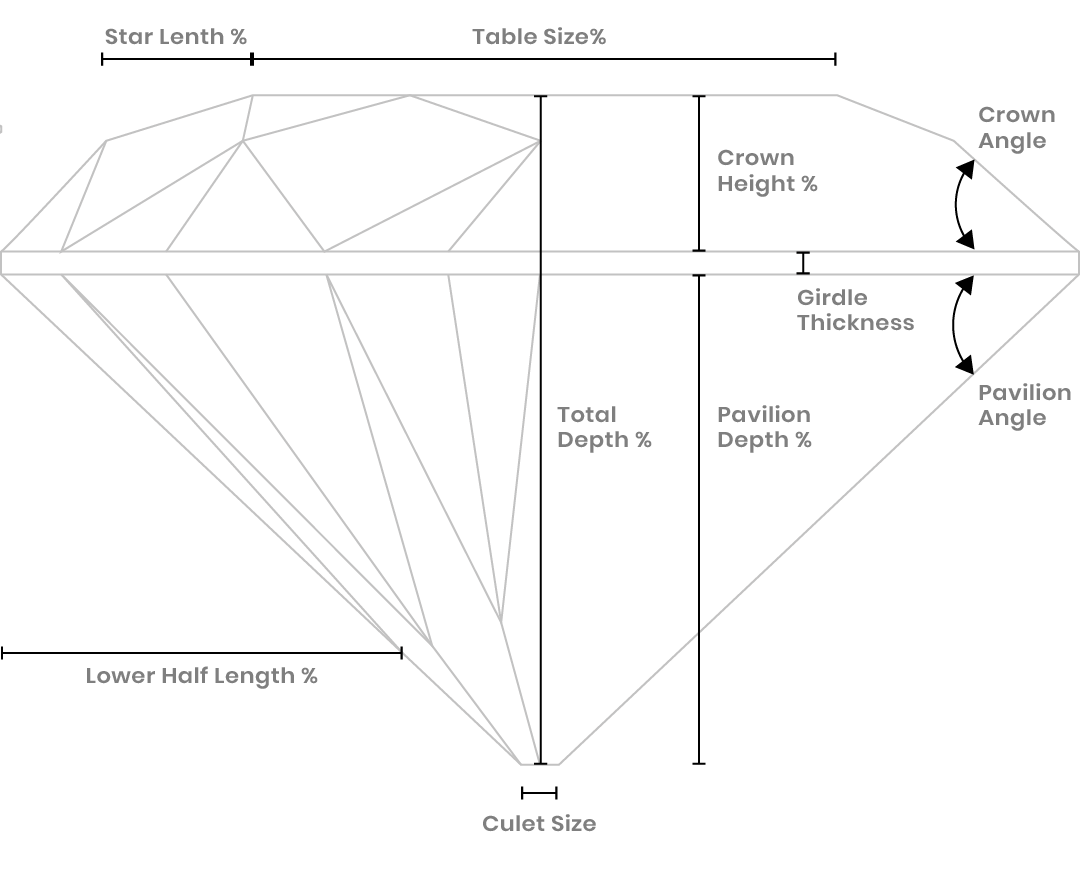About Diamonds
Anatomy and cutBrief History
Diamond forms under high temperature and pressure that exists deep under the earths crust. Pure diamond is composed of only one single element CARBON and these atoms are bonded together in the same way in all directions making it the hardest mineral known to man. Formed between 1 and 3.3 billion years ago diamonds are forced upwards to the earths surface by volcanic activity. Once recovered, sorted and polished diamond now shows its true beauty possessing a combination of brightness, brilliance and fire not matched by any other gemstone.


Anatomy & Cut Quality
One of the most important characteristics of a diamond is the cut. The cut of a diamond determines the fire, brilliance and scintillation. If a diamond is cut incorrectly it will result in a dull muted appearance. When cut to perfect proportions and symmetry a diamond will radiate a brilliance second to none.


Understanding the 4 C’s of Diamonds
The 4Cs represent a diamond’s specific characteristics, the combination of Cut, Colour, Clarity and Carat weight all influence a diamond’s value and rarity.
Clarity
Clarity refers to the presence of inclusions in a diamond. Naturally-occurring features called inclusions provide a special fingerprint within the stone. Inclusions are natural identifying characteristics such as minerals or fractures, occurring while the diamond was being formed in the Earth. The majority of these natural birthmarks are invisible to the naked eye, yet they affect the way light is reflected and refracted within the stone.
Most inclusions are not visible to the naked eye unless magnified. To view inclusions, gemmologists need to use a magnifying loupe that allows them to see a diamond at 10x its actual size. Inclusions are ranked on a scale of perfection, known as clarity. The clarity scale, ranging from F (Flawless) to Included (I), is based on the visibility of inclusions at a magnification of 10x.
There are very few flawless diamonds found in nature, making these diamonds much more valuable.


Cut
Cut refers to the angles and proportions of a diamond. It is the only one of the 4Cs that is influenced by the human hand. Diamond cutting requires great skill and training. The cutter must polish tiny surfaces known as facets onto the rough diamond. This process is what creates the facets known as the crown, culet, table, girdle and pavilion of the diamond. To cut a diamond perfectly, a craftsman will often need to cut away more than 50% of the rough diamond.
A well-cut diamond will be higher in quality and value than deep or shallow-cut diamonds. Diamonds that are cut too deep or too shallow lose or leak light through the side or bottom, resulting in less brilliance and a less valuable stone. Cut also refers to the shape of a diamond.


Colour
Colour refers to the degree to which a diamond is colourless. Diamonds can be found in many colours, however white-coloured or colourless diamonds remain the most popular. Diamonds are graded on a colour scale which ranges from D (colourless) to Z. Warmer coloured diamonds (K–Z) are particularly desirable when set in yellow gold. Icy winter white coloured diamonds (D–J) look stunning set in white gold or platinum.
Colour differences are very subtle and it is very difficult to see the difference between an E and an F, for example. Therefore, colours are graded under controlled lighting conditions and are compared to a master set for accuracy.
Nature has also created diamonds in shades of blue, green, yellow, orange, and pink. Red is the rarest of all. These diamonds are called ‘coloured fancies’ and are extremely rare and highly treasured.


Carat (Size)
Carat refers to the weight of a diamond, Often mistaken with size, carat is actually a measure of weight. The term carat is a derivative of the word carob. Carob seeds, which are surprisingly uniform in weight, were used as a reference for diamond weight in ancient civilisations. One carob seed equalled one carat.


Contact Us
Come and Visit Us

Our opening hours are:
Monday to Saturday 10am until 5pm.
We are closed on Sundays, all bank holidays and we are closed between Christmas and New Year.
To arrange an appointment you can call us on 01434 633302, or email [email protected]
